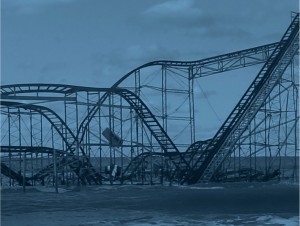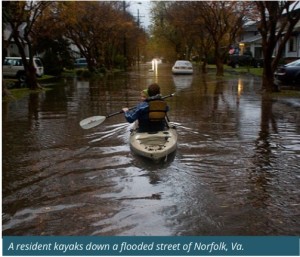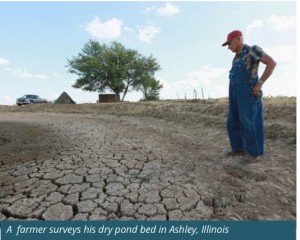Background
A seminal project to identify and assess the economic implications of climate change was the Stern Review: The Economics of Climate Change, commissioned by the UK government and published in 2006, under the leadership of Sir Nicholas Stern. Now we have a research and policy study that attempts to assess the future effects of climate change on the American economy. The report is Risky Business: The Economic Risks of Climate Change in the United States (June 2014), and it is a product of the Risky Business Project. This Project was launched in October 2013 to focus on quantifying and publicizing the economic risks from the impacts of a changing climate. The founders, and funders, include a set of private business leaders, co-chaired by Michael Bloomberg, former mayor of New York City and founder of Bloomberg LP, a sometime Republican, Democrat and Independent; Henry Paulson, a former Chairman of Goldman Sachs, former Secretary of the Treasury under President George W. Bush, and a conservationist; and Tom Steyer, an “active citizen,” former hedge fund manager, philanthropist and environmentalist, and significant funder of Democratic causes and climate change projects. Others participating in the Project are also well-connected and represent diverse political positions.
Scope of the Study
The study, undertaken for the Project by consultants, uses risk assessment methodologies to estimate the impacts of climate change in different sectors of the American economy and in each of the different regions of the US. The focus is on damage to coastal property and infrastructure from rising sea levels and increased storm surge, climate impacts in agricultural production and energy demand, and impacts of higher temperatures on labor productivity and public health. The researchers analyse the outcomes most likely to occur, but also lower-probability, higher-impact events (so-called “tail risks”), which are becoming more frequent. Assessments are included at the county levels in most regions, especially for coastal counties. Finally, the study concentrates on the results following a business-as-usual, or current path, economy, assuming no successful national or global action to mitigate emissions. We will return to this particular approach in the Conclusion.
Some of the Hard Numbers
In a useful metaphor, the report claims that we are treating climate change as if it were an interest-only loan, where we pay a minimal carrying cost and leave to future generations the burden of paying off the principal. Of course the future generations will likely never have the resources to pay for the full costs of climate change.
Perhaps the marker most relied on in the Report is the number of days when the temperature will rise above 95°F, again assuming nothing is done to reduce emissions. Over the past several decades, we have seen the number of over 95°F days average out, across the country, at about 12-25 days per year. By 2050 (only 35 years away) the average American will likely experience 27 to 50 days each year when the temperature will rise above 95°F. By 2100, we will experience on average 45-96 days per year of over 95°F, or 1.5 to 3 months a year of what are considered record high temperatures. As we shall see below, some regions will experience many more extremely hot days.
Such temperature rise will exert a powerful strain on our energy systems, with air conditioning becoming quite simply a matter of survival.
Of course some regions will be worse because of the record temperatures combined with high humidity. The combination will make outdoor conditions literally unbearable, and deadly for many. People who work outdoors just won’t be able to do so on such days. If the temperature and humidity continue to rise, we likely will reach days when we exceed the “Humid Heat Stroke Index,” where humans will not be able to maintain a skin temperature below 95°F, necessary to cool down and avoid fatal heat stroke. Labor productivity will of course suffer.
People with limited resources, many of whom engage in heavy labor outside, will bear the brunt, unable to work for many days and unable to afford air conditioning. Older Americans, including the Baby Boomers, will also suffer from these effects more than others.
Besides the impact on human health, high temperatures also affect our planet in many ways, including higher ocean temperatures, and resulting ocean expansion and sea level rise; accelerated land ice melts, with more sea level rise; and more extreme precipitation, making some regions even wetter. Hotter, drier conditions will also result in increased groundwater withdrawal that can sink land adjacent to oceans, exacerbating sea level rise.
A recent US study by NASA found that “Unprecedented drought conditions” — the worst in more than 1,000 years — are likely to come to the Southwest and Central Plains after 2050 and there’s more than an 80 percent chance that much of the central and western United States will have a 35-year-or-longer “megadrought” later this century. Megadroughts, like the 1930s Dust Bowl, last for decades instead of just a few years.
Rising seas with stronger storm damages will wipe out many properties and infrastructure, especially along the Eastern Seaboard and Gulf Coast. The report estimates that by 2050, between $66 billion and $106 billion of coastal property, nationwide, will be below sea level, and between $238 and $507 billion, or as much as $730b, by 2100. People with mortgages in these areas will see their properties disappear before the notes are paid. The more people learn of these coming impacts, the quicker insurance and re-sales will also disappear.
One of the major contributions of the report is the differentiation of the impacts on eight different regions of the US, many of which have different economic and physical characteristics. Some of the differences are discussed below.
Regional Impacts
In the Northeast region, sea level rise and storm surges will dominate the effects of climate change. About 88% of the people live in, and 68% of the region’s Gross Domestic Product (GDP) is generated in low-lying coastal areas in this region. Sea levels will rise from between 2 and 7 feet by the end of the century, only 85 years away. So many of those born from now on will be here to experience such dramatic changes. The region also has many large urban areas and the “urban heat island” effect will increase average temperatures by about 5°F during the day and 22°F in the evening over surrounding rural areas. Sea level rise, combined with extreme storm events will increase average annual property losses by $6 to $11 billion over the rest of the century. Currently there are 2.6 days/yr of over 95°F, by 2050 there will be 4.7 to 16 additional days, and by 2100 there will be 15-57 additional days, or 2 months of over 95°F. Such conditions present significant health risks, especially in major cities in the region.
The Southeast region has only 36% of people, and 33% of GDP in coastal counties, but these counties include major cities like New Orleans, which is below sea level, and Miami, which is built on porous limestone that allows water to inundate areas even where there is a sea wall. In addition, Norfolk Virginia has the nation’s largest naval base and it is vulnerable to sea level rise of 2.5 to 4.4 feet, with the possibility of a 7-foot rise, by 2100. The SE region will be especially vulnerable to high temperatures, going from 9 days/yr of over 95°F, to 17-53 additional days by 2050, and 47-115 additional days by 2100, or as much as 4 months of days over 95°F. Such temperatures will adversely affect labor productivity in mining, utilities, transportation, agriculture and manufacturing. Over the century the region will also experience 11,000 to 35,000 deaths per year. As noted, as a practical matter, Chicago did not have places to even properly store the 700 bodies of people who died in a heat wave in 1995.
The Midwest region is an important agriculture producing area and some states will likely find a 15% drop in crop yield by 2050, and a 73% drop by 2100. Unlike the NE where the infrastructure is at significant risk, and infrastructure does not move well, the threats to agriculture can be managed by shifting crop production from the Midwest to the Upper Great Plains, Northwest and Canada. That will preserve the total crop yields but the Midwest region will become a poorer and less populated place, and not everybody will be capable of moving north along with the crop production. Currently the region experiences 2.7 days/yr of over 95°F, and it will likely see 7-26 additional days by 2050, and 20-75 additional days by 2100, much lower than the SE region, and with fewer days with freezing temperatures. Unfortunately, the region experiences high humidity and with the higher heat, and there are serious implications. By the end of this century the combined heat and humidity could exceed the Humid Heat Stroke Index during which days “it will be functionally impossible to be outdoors.” At 31.
The Great Plains has a mixed climate with the southern states hot and the northern states cold. With climate change the southern states will go from 35 days of over 95°F, to 26-56 additional days by 2050, and 50-108 additional days by 2100. Air conditioning demands for energy will increase commensurate with temperature rises. As the region is a major producer of energy (Texas and Wyoming produce half of US energy), this is good news. If that energy supply remains based on fossil fuels, that is bad news. In contrast, the northern Great Plains will go from 159 days with below freezing temperature to 117-143 days/yr below freezing in 2050, and 79-122 days/yr below freezing by 2100. Coastal counties in Texas will see sea level rise of 1.5 to 2 feet by 2050, and 3.2 to 4.9 feet by 2100. While the climate differs significantly between Southern and Northern Plains, their economies both rely on agriculture and energy. Currently about 80% of the region is devoted to cropland, pastures and range land, producing $92 billion in agricultural products. As climate change unfolds the southern states will see drops in crop yields while the northern states will see crop yields rise, assuming water remains available, a rather large assumption.
The Pacific Northwest will see 5 days/yr of hot days rise to an additional 18 to 42 days of hot days/yr by 2100, lower than other regions but hot enough for the NW. With its coastal counties, sea level will rise to about a foot by 2050, and 1.6-3 feet by 2100, again not significant compared to other regions. Where the NW will suffer is in its heavy dependence on forests, which produce more than $11 billion in wood sales in just Oregon and Washington. Wildfire, drought and wood damage from pests will increase burned areas by as much as 54% to 175%.
The Southwest region is already warm and dry, with about 40% covered by desert. Also there have been, region-wide, about 40 days of over 95°F, with an expected rise to 13-28 additional days by 2050, and 33-70 additional days by 2100, or about 3.5 months by 2100. About 87% of the people, and 80% of the GDP, come from coastal communities in California. In addition, San Diego is a critical US military area, home to numerous military installations. Sea level is expected to rise by 1.9 to 3.4 feet by 2100. With the rise in temperature, there will be less snow and snow melt in the mountains with higher evaporation of water reservoirs in already stressed water conditions.
The remaining two regions are Alaska and Hawaii. Alaska earns 80% of its GDP from oil and gas production. At the same time, fisheries and tourism are the 3rd and 4th largest contributors to its economy, and 86% of GDP comes from coastal counties. In effect the climate emissions from its largest industry, oil and gas, are literally destroying the seafood industry and coastal communities, earning Alaska the title as “ground zero” for climate change impacts. By 2050, average temperatures will rise by 3.9 to 8°F, and 7.6 to 16°F by 2100, resulting in up to a 50% decrease in freezing days per year. Unlike most other regions, Alaska will experience a fall in sea level in some places due to its proximity to glaciers and to shifting tectonic plates. The same cannot be said about Hawaii which will experience temperature rises of up to 7.7°F or even over 9°F by 2100 and sea level rise greater than global average. These changes will have significant impact on its economy as both 100% of the people live in, and 100% of its GDP comes from, coastal communities.
Conclusion: Stern-lite
One of the strengths of the Stern Review was its explicit, and well-supported, bottom line: “the evidence gathered by the Review leads to a simple conclusion: the benefits of strong and early action far outweigh the economic costs of not acting.” At 2. The Review also quantified that conclusion, finding that if we don’t act now, “the overall costs and risks of climate change will be equivalent to losing at least 5% of global GDP each year, now and forever,” and if the impacts are worse than anticipated, damages could rise to 20% of GDP or more. In sharp contrast, the actual costs of reducing greenhouse gas emissions to avoid the worst impacts of climate change can be limited to around 1% of global GDP each year. There was no doubt that the science and math demanded action now to mitigate emissions.
The same cannot be said for the Risky Business Project report that takes a different tack. Underlying the assessment seems to be a hard-nosed pragmatism at work: let’s assume the worse (no mitigation) and see what happens. The focus is at all times on adaptation, as reflected at the end where the “Next Steps” are all about adaptation. At 46-47. There are only a few, unpersuasive, references to the need for mitigation.
Occasionally we find a few passing references to some costs that will follow this business-as-usual path, including general costs from the loss of infrastructure or rising energy costs or drop in labor productivity. But there is no comprehensive estimate of the dollar value of the impacts without mitigation.
For example, we noted that a critical marker is the increase in number of days with temperatures above 95°F. The Risky Business report details for each region how many such days there will be, in 2050 and 2100, and that is helpful. But it would have been even more helpful to know what adaptation measures would be necessary to deal with the number of extreme hot days and the added costs of those extremely hot days. In order to convince others to engage with climate change actions, it would be even more helpful to know what it would cost to reduce emissions, now and over the next several decades, so that we avoid so many days above 95°F.
Moreover there is no sense of the harsh realities that will follow these climate changes from business-as-usual behavior on ordinary citizens and workers. For example, it is suggested that as temperatures rise and agriculture crop yields fall in southern US but rise in northern US and Canada, everybody will switch crops or just move north, acknowledging in passing that some farmers might not be able to do so. Big agribusinesses likely will have the resources to do so. But farming families in the losing zone cannot just pick up and move north. First, they likely have lived in their community for years, decades, or generations. They are likely heavily in debt, with mortgages on their home and equipment. With the fall in crop yields, and end of agriculture, their property will be worth less, if anything. How do they get the money for any move north, where the price of land and equipment will likely skyrocket? And if any move has to be to Canada, maybe Canadians will adopt some of the anti-immigration attitudes and policies dominate in parts of the US.
The report also points out, in rather stark terms, that by the end of this century during days of combined heat and humidity “it will be functionally impossible to be outdoors.” That scenario needs to fleshed out with some sense of the harsh realities of such a change and the costs, both in economic and human terms.
The Project’s take away message is that it must become standard, state-of-the-practice for US business and investment communities to factor future climate-change impacts into present-day decision making. As they say, ‘it is time for all American business leaders and investors to get in the game and rise to the challenge of addressing climate change.” At 45 (Emphasis added). This call for action is aspirational only, because it lacks the analytic tools or data to get into the game. We have little idea of how much the ticket to the game will cost.
Don’t get me wrong. We should be delighted that a group of smart, rich, articulate, and well-respected members of the business community are committed to convincing those more reluctant to start making decisions now based on future inevitable climate changes. And we hope it works. And perhaps the Project plans to carry on with more detailed analysis of the options for mitigation and adaptation, and the costs for each option.
But we cannot ignore the present shortcomings. Rich people, and rich nations, can afford to focus on adaptation because they will likely be able to afford whatever is necessary to protect their economy, including its infrastructure. Rich people can always move to higher ground or more friendly climates to avoid the worst impacts. At the same time, it is important that they do not forget that their fortunes were made with obvious ingenuity and drive, perhaps some luck, but also with the help of energy driven by cheap fossil fuels, the emissions from which remain in our collective atmosphere.
Sources
The Risky Business Project, Risky Business: The Economic Risks of Climate Change in the United States (June 2014) (updated September 2014). riskybusiness.org
Sir Nicholas Stern, Stern Review: The Economics of Climate Change mudancasclimaticas.cptec.inpe.br/~rmclima/pdfs/destaques/sternreview_report_complete.pdf
Burt Helm, “The Climate Bottom Line,” The New York Times (1 Feb 2015). www.nytimes.com/2015/02/01/business/energy-environment/climate-changes-bottom-line.html
Seth Borenstein, “U.S. ‘Megadroughts’ Are Likely Later This Century, Study Finds,” Huffington Post Green (12 Feb 2015). www.huffingtonpost.com/2015/02/13/us-megadroughts-study_n_6671812.html?utm_hp_ref=green







No comments yet, add your own below